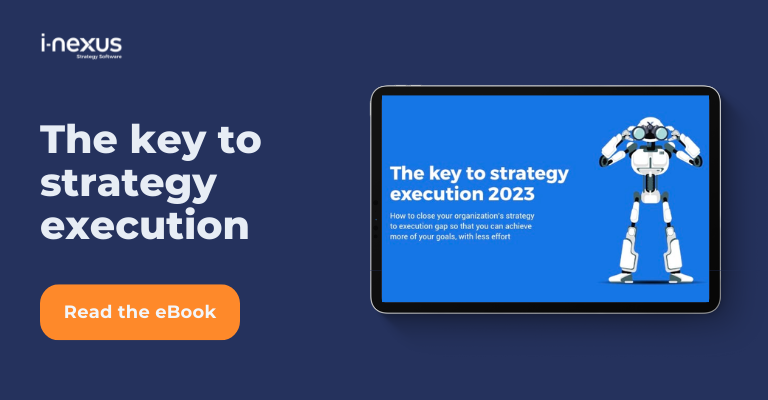Learn the simple process to help you complete effective strategic reviews.
Revisiting old ground with a fresh perspective
It seems a little odd to write a blog on a process that we would think everyone follows: strategic reviews.
Am I covering new ground? No, I wouldn’t have thought so. Perhaps it’s more of a perceived need on my part to revisit this practice in light of today’s continuous strategy manifesto.
This blog explores the ever-important topic of strategic reviews and how they help you to oversee strategy execution as you explore the value of a continuous strategy approach.
Portfolio v strategy review
I think back to the concept of a portfolio review.
The Chief Technology Officer and management team would meet quarterly to review the project portfolio’s performance, asking:
- Are projects proceeding as planned?
- Do we need to make any changes to the portfolio?
- Are the active projects aligned with strategic objectives and attractive in terms of economic and strategic value?
Interestingly, the portfolio review assumes your product investment strategy is correct.
Likely set annually, the strategy isn’t reviewed to ensure it remains fit for purpose. Rather it is replaced in time for the next planning cycle.
And herein lies the new challenge: how do you keep your finger on the pulse of not just the strategic plan but the strategy itself?
The answer lies in every Chief Strategy Officer (CSO) and Head of Strategy’s good friend the strategic review, retooled for modern times.
Strategy reviews provide that metronomic opportunity – typically monthly – for yourself, your management, and other key stakeholders to answer four critical questions:
- How well is an activity in the strategic plan proceeding?
- Do we see the results we expected?
- Are there any factors that might cause us to change our strategic plan?
- Are there strategic issues that might cause us to revisit the strategy?
Now let’s explore how you might answer these questions using strategic reviews.
How well is an activity in the strategic plan proceeding?
The strategic plan contains delivery expectations for workstreams, project portfolios, and other types of activity (such as countermeasures and daily management tasks).
The strategic review gives early visibility into delivery challenges or risks that stand in the way of your success.
Using something like a KPI bowling chart – a color-coordinated visual management tool – reviews can focus on the questions that matter based on data, not gut feel.
Management can “follow the red” and focus on bringing those wayward activities back on plan.
The portfolio review will often closely monitor risk logs to proactively address delivery issues even before delivery lags or veers off course.
Do we see the results we expected from our strategic plan?
Herein lies a difference between strategic reviews and portfolio reviews.
Strategic reviews must not just consider activity or portfolio performance.
It must also monitor whether this activity achieves the desired results, measured by KPIs aligned to strategic objectives.
Don’t confuse portfolio performance with plan and performance regarding impact or realized results.
This exercise will identify another reason to correct course – to better align activity to results.
Are there any factors that might cause us to change our strategic plan?
Changes made on the back of this performance insight might include:
- Redirecting resources
- Suspending workstreams
- Launching countermeasures
- Accelerating the refinement of promising new ideas
When making any adjustments, you and the management team will consider the impact of realized results.
Are there strategic issues that might require us to revisit the strategy?
Answering this question takes the focus temporarily away from the strategic plan and back to the strategy itself.
In answering this question, we must look for triggers and events that might signal market disruption or negatively impact the strategic plan.
Some companies maintain a list of strategic issues to monitor, either through the manual or automated environment and horizon scanning.
Strategic issues come from the ROTA – strategic issue framework:
- Risks which are conditions that might prevent success
- Opportunities for growth or another strategic priority area
- Threats that might influence your strategic decisions
- Assumptions upon which the strategic plan is built
How a strategic review session works
Now that we’re clear on what we’re trying to achieve let’s review how a strategic review might work with you at the helm.
Frequency of review
Strategic reviews are typically held monthly. But decide what works best for your organization.
For example, monthly strategic reviews might focus on activity performance to plan and strategic plan viability.
Then, ongoing strategy viability is added to the agenda every quarter to consider outstanding strategic issues.
Depending on your approaches, such as OKR or Hoshin Kanri, you will likely be comfortable with having different reviews held at particular intervals.
Ongoing strategy is no different.
Stakeholders and attendees to a strategic review session
Again, while casting will depend on your organization and its approach to strategy execution mobilization, some guiding principles apply.
These reviews get to the heart of whether your:
- Strategy is right
- A strategic plan is right
- The organization is making progress
And for those reasons, strategy sponsors from the executive leadership teams must attend, together with representatives of any facilitating teams (e.g., your Strategy Realization Office or Program Management Office) and owners of any significant strategic activity workstreams, such as your Strategy Managers.
Hitting the right tone
“Red is bad.” “No such thing as amber.”
On the execution side, the reality is that “red” is good and means more “I need help” rather than “I’m failing”.
At least, that’s the cultural maturity we’d all hope for.
Similarly, there’s no shame in revisiting your strategic plan or even the strategy.
That agility and responsiveness are something we should all strive for as traditional annual strategic planning struggles for relevance in the face of uncertainty.
Indeed it’s better to catch a necessary strategic pivot as early as possible rather than stubbornly stay the course.
Learn about tone and how to tell the right story with your strategy in our key to strategy execution eBook.
Maximize strategic discussion by minimizing overhead
Technology can help here.
Any time spent preparing reports is better spent discussing the data and extracting every ounce of possible insight.
After all, it is in the execution of our strategies where value is lost.
With that in mind, strategy software, like i-nexus, maximizes the focus on the strategic discussion by minimizing time invested in gathering data, preparing reports, and distributing them ahead of the strategic review.
Strategy software also manages risks and strategic issues, ensuring that up-to-date data is always available for review.
Go forth and review
If we are to become more “continuous” in our approach to strategic planning, we need a construct for regular review and more frequent than its cousin, the quarterly portfolio review.
A monthly strategic review – attended by sponsors and Program Managers, plied with quality management reporting – will go a long way to building in regular calibration events that validate your direction is correct, and progress is on track.
Taking the next step
Start by building a consolidated list of strategic issues categorized by type for your current organization's strategy and plan.
You can then get a holistic sense of priorities based on impact and begin to arrive at a review frequency for each strategic issue.
Learn more about continuous strategy and strategy execution
Take the next steps in your journey to embracing continuous strategy by exploring our strategy execution resource hub or any of the below:
- Key to strategy execution eBook: Read how companies like Danaher and HP have mastered strategy execution and what you can learn from them.
- What does it mean to be Business Agile?: Leap into the future of strategic planning and execution with this fascinating insight.
- How AI and Machine-Assisted Learning will help strategy execution: As Artificial Intelligence becomes a mainstay in our lives, read how AI and machine-assisted learning will evolve to support your strategy execution.
About the author
James Davies is i-nexus’ Chief Product Officer. As an experienced software executive with 20 years of experience working in Silicon Valley, USA, James has held senior leadership roles in three venture capital-backed software start-ups (including CEO, CPO, and Chairman). He has delivered management consulting services to some of the world’s largest technology companies.
If you’d like to talk more about the future of strategy execution, reach out to him on james.davies@i-nexus.com or connect with James on LinkedIn for the latest insights





